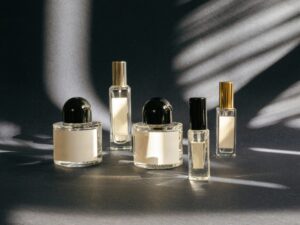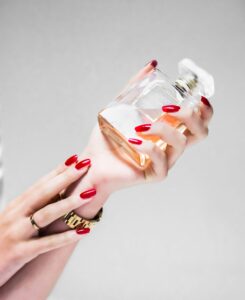1. What’s the difference between parfum, eau de parfum, and eau de toilette?
Parfum (or extrait de parfum) has the highest concentration of fragrance oils—typically 20–30%—making it the most intense and long-lasting. Eau de parfum (EDP) has around 15–20% oil concentration, while eau de toilette (EDT) is lighter with about 5–15%. The lower the concentration, the lighter and often shorter-lived the scent.
2. What does “sillage” mean in perfumery?
Sillage refers to the scent trail a perfume leaves behind as someone moves. A strong sillage means the fragrance lingers in the air and is noticeable to others even after you’ve passed by.
3. How long does a fragrance last on the skin?
It depends on the fragrance type, your skin type, and where you apply it. Parfum can last 8–12 hours or more, while EDTs may fade after 3–5 hours. Oily skin tends to retain fragrance longer than dry skin.
4. How should I store my fragrances to make them last?
Keep them away from direct sunlight, heat, and humidity. Store them in a cool, dark place like a drawer or cabinet. Avoid keeping them in the bathroom.
5. What’s the difference between niche and designer fragrances?
Designer fragrances are mass-produced by fashion brands like Chanel or Dior and tend to appeal to a broad audience. Niche fragrances are made by independent or specialized perfume houses and often emphasize artistry, unique ingredients, or bold concepts.
6. Why do some perfumes smell different on different people?
Your skin’s pH, natural oils, diet, and even medications can alter how a fragrance interacts with your body. What smells warm and creamy on one person might turn sharp or powdery on another.
7. What are top, middle, and base notes?
8. Are synthetic ingredients bad in perfumery?
Not at all. Many synthetic ingredients are safe, sustainable, and essential to modern perfumery. They help replicate rare natural scents and improve longevity, consistency, and performance.
9. How can I tell if a fragrance is high quality?
Look for complexity, balance, and how well the notes evolve over time. A high-quality fragrance won’t smell flat or disappear quickly, and it often unfolds in layers. Longevity and sillage are also indicators, though they vary by style.
10. What’s a blind buy—and should I do it?
A blind buy is purchasing a fragrance without testing it first. It can be thrilling but risky. If you’re new to scent, try sample sizes or decants first before investing in a full bottle.
11. How do I build a fragrance collection?
Start with a few versatile fragrances—daytime, evening, and special occasion scents. Sample widely and give each scent time to develop on your skin. Think about seasons, moods, and styles you want to express.
12. What does “unisex fragrance” mean?
Unisex fragrances are marketed without gender labels and can be worn by anyone. They often blend traditionally “masculine” and “feminine” notes like citrus, woods, florals, or musks.
13. Why are some fragrances so expensive?
High prices can come from rare natural ingredients, long aging processes, artisanal craftsmanship, or branding. However, expensive doesn’t always mean better—some affordable perfumes perform beautifully.
14. What’s the best way to apply fragrance?
Spray it on pulse points like the neck, wrists, and behind the ears. Don’t rub your wrists together—it breaks down the top notes. You can also spritz your clothes or hair lightly for more projection.
15. What’s the difference between projection and sillage?
Projection is how far the scent radiates from your body. Sillage is the trail left behind as you move. Some perfumes have great projection but low sillage, and vice versa.



